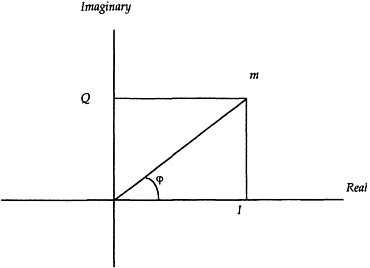262.
| [Cover] [Contents] [Index] |
Page 34
An electromagnetic wave, besides being described in terms of wavelength and amplitude, can also be characterised using complex number format (a complex number consists of a two components, termed the real and imaginary parts). When the co-ordinate system is translated into both the real and imaginary axes (Figure 1.19), the wave is described by two parameters namely, the in-phase I (I=m·cosφ) and quadrature Q (Q=m·sinφ) components. Both the I and Q parameters provide the wave’s overall phase φ (φ =tan−1(Q/I)) and magnitude m (m=(I2+Q2)0.5) as illustrated in Figure 1.19. Radar phase represents the degree of coincidence in time between a repetitive radar signal and a reference signal having the same frequency. Over the complex domain, the amplitude a is expressed as a=I+iQ, where I= (−1)0.5. The relationship between the magnitude m and a complex amplitude a, by definition, can be expressed as m=|a|, i.e. the absolute value of amplitude. The radar image can thus be formed by using any of the m, I, or Q components. As a result, this kind of radar image is said to be represented in complex format.
Complex format radar imagery can be used to generate interferometric information (Massonnet and Rabaute, 1993; Zebker et al., 1994; Gens and van Genderen, 1996), which is useful in producing digital elevation models (DEM) (Zebker et al., 1994; Lanari et al., 1996), or in monitoring large scale surface changes (Massonnet et al., 1993; Goldstein et al., 1993). The potential of SAR interferometry in land cover classification is the subject of current investigations (e.g. Ichoku et al., 1998).

Figure 1.19 Wave described by complex (real and imaginary) coordinates.
| [Cover] [Contents] [Index] |
EAN: 2147483647
Pages: 354